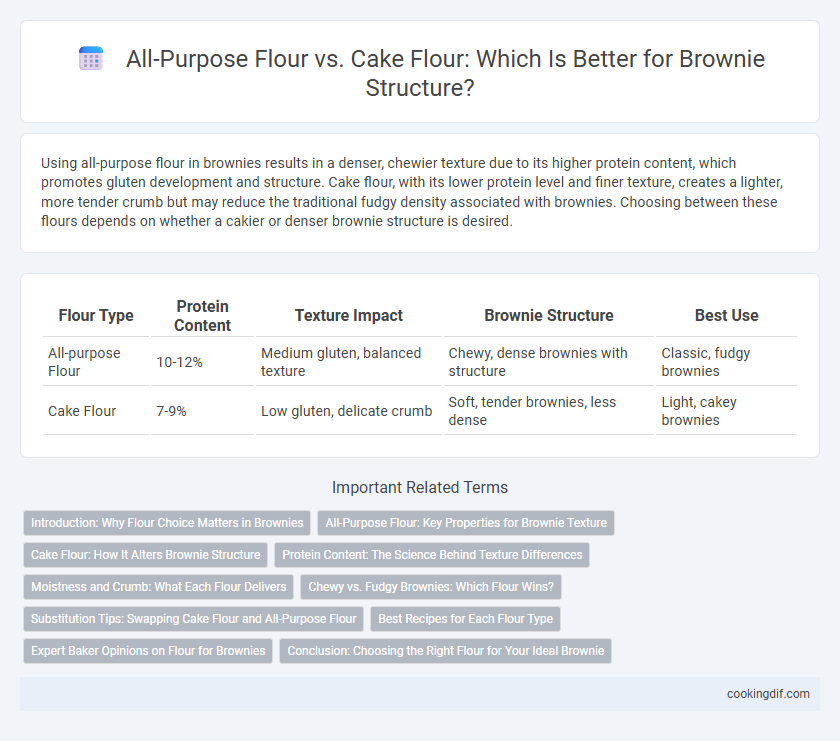Using all-purpose flour in brownies results in a denser, chewier texture due to its higher protein content, which promotes gluten development and structure. Cake flour, with its lower protein level and finer texture, creates a lighter, more tender crumb but may reduce the traditional fudgy density associated with brownies. Choosing between these flours depends on whether a cakier or denser brownie structure is desired.
Table of Comparison
| Flour Type | Protein Content | Texture Impact | Brownie Structure | Best Use |
|---|---|---|---|---|
| All-purpose Flour | 10-12% | Medium gluten, balanced texture | Chewy, dense brownies with structure | Classic, fudgy brownies |
| Cake Flour | 7-9% | Low gluten, delicate crumb | Soft, tender brownies, less dense | Light, cakey brownies |
Introduction: Why Flour Choice Matters in Brownies
All-purpose flour provides a balanced protein content that creates a chewy, dense brownie texture, making it ideal for traditional fudgy brownies. Cake flour, with its lower protein and finer texture, produces a lighter, more tender crumb that results in cakier brownies. Choosing between these flours directly impacts the structural outcome and mouthfeel of your brownies.
All-Purpose Flour: Key Properties for Brownie Texture
All-purpose flour contains a moderate protein content, typically around 10-12%, which provides a balanced gluten formation ideal for achieving a chewy yet tender brownie texture. Its versatile structure allows brownies to rise moderately, creating a dense but moist crumb that enhances overall mouthfeel. Using all-purpose flour ensures optimal structural integrity while maintaining the fudgy characteristics essential for classic brownie recipes.
Cake Flour: How It Alters Brownie Structure
Cake flour's lower protein content reduces gluten formation, resulting in a softer, more tender brownie crumb. This flour produces a delicate structure that is less dense and chewy compared to all-purpose flour brownies. Using cake flour enhances the fudgy texture by creating a finer, lighter crumb ideal for moist, melt-in-your-mouth brownies.
Protein Content: The Science Behind Texture Differences
All-purpose flour contains higher protein content, typically 10-12%, which forms more gluten and results in a denser, chewier brownie texture. Cake flour has lower protein content, around 7-9%, producing less gluten and yielding a softer, more tender crumb in brownies. Understanding these protein variations is essential for achieving the desired structural balance between fudgy and cakey brownies.
Moistness and Crumb: What Each Flour Delivers
All-purpose flour provides a balanced protein content that creates a denser, chewier brownie with a slightly firmer crumb, contributing to a moist but not overly soft texture. Cake flour contains less protein, resulting in a lighter, more tender crumb that enhances moisture retention and delivers a softer, melt-in-your-mouth brownie experience. Choosing all-purpose flour yields robust structure and chewiness, while cake flour optimizes moistness and delicate crumb for a tender bite.
Chewy vs. Fudgy Brownies: Which Flour Wins?
All-purpose flour provides higher protein content, resulting in more gluten development that creates chewy brownies with a denser texture. Cake flour, with its lower protein content, produces less gluten, yielding fudgier, tender brownies that melt in your mouth. Choosing between these flours depends on whether you prefer a sturdy chew or a soft, moist bite in your brownie structure.
Substitution Tips: Swapping Cake Flour and All-Purpose Flour
Swapping cake flour for all-purpose flour in brownie recipes softens the texture by reducing gluten content, producing a more tender crumb. When substituting, use 1 cup plus 2 tablespoons cake flour for every cup of all-purpose flour to maintain proper structure. Incorporate a teaspoon of cornstarch per cup of all-purpose flour as an alternative to mimic cake flour's lower protein level and enhance fudginess.
Best Recipes for Each Flour Type
All-purpose flour provides brownies with a denser, chewier texture ideal for fudgy recipes, while cake flour produces lighter, airier brownies with a tender crumb perfect for cakey variations. Recipes using all-purpose flour often include higher cocoa butter content and minimal leavening to maintain a rich, moist structure. Cake flour-based brownie recipes typically incorporate additional eggs and baking powder for lift, creating a delicate balance between softness and slight springiness.
Expert Baker Opinions on Flour for Brownies
Expert bakers emphasize that all-purpose flour provides brownies with a denser, chewier texture due to its higher protein content, ideal for hearty, fudgy brownies. Cake flour, with lower protein and a finer grind, yields a lighter, more tender crumb that suits cakier brownie varieties. Choosing the flour depends on desired brownie structure, with many professionals recommending all-purpose flour for traditional dense brownies and cake flour for softer, airy results.
Conclusion: Choosing the Right Flour for Your Ideal Brownie
All-purpose flour provides a balanced protein content of about 10-12%, resulting in a chewy and dense brownie structure, while cake flour, with its lower protein content of around 7-8%, yields a softer and more tender crumb. For fudgy brownies that hold their shape well, all-purpose flour is the ideal choice; soft and cakey brownies benefit from the lighter, delicate texture that cake flour offers. Selecting the right flour depends on your preferred brownie texture, with all-purpose flour best for rich solidity and cake flour for a melt-in-your-mouth softness.
All-purpose flour vs Cake flour for brownie structure Infographic

 cookingdif.com
cookingdif.com